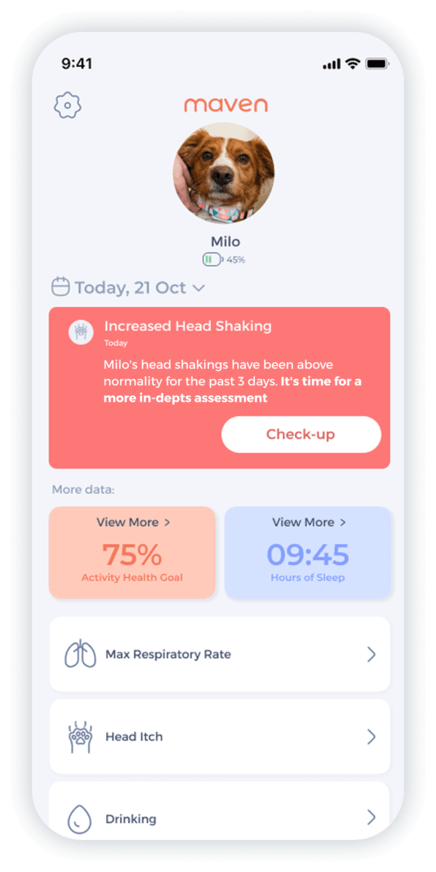Why Is My Dog Limping? Common Causes and When to Worry (Vet Verified)
Discovering your dog is limping or favoring one leg can instantly cause panic. Since dogs can’t tell us what hurts, it’s up to you to assess the situation and figure out whether it’s a minor sprain from rough play or a sign of a serious condition like a fracture or ligament tear. If you’re wondering “why is my dog limping?”, this vet-verified guide will walk you through the most common causes of limping in dogs, provide guidance on at-home care, and, most importantly, tell you exactly when to worry and seek urgent veterinary care.
Key Takeaways
- Limping is a pain signal.
- The difference between sudden limping and a gradual limp matters.
- Signs like visible deformity, dragging a limb, or inability to bear weight require an immediate vet visit.
- Using a dog health tracker like the Maven Pet Health Monitor can provide objective data to help you and your vet catch subtle mobility changes early.
Why Is My Dog Limping?

A dog limps when they are unable to put full weight on one or more limbs due to pain, weakness, or a lack of coordination.
To begin your assessment, watch your dog walk and try to determine:
- Which leg is affected?
- Is the limping sudden or gradual?
- How severe is it?
Common Causes of Limping in Dogs
Limping can affect any part of the leg, from the paw and toes, up to the joints and the spinal column.
- Paw Injuries: Foreign bodies (thorns, glass), cuts on the paw pad, or a fractured/torn nail. These often cause a sudden limp.
- Soft Tissue Injury: Sprains (ligaments) or strains (muscles/tendons) from over-exercising or landing wrong.
- Arthritis: Degeneration of joints, commonly seen in middle-aged and senior dogs. It’s gradual and causes intermittent limping.
- Fracture or Dislocation: A broken bone or joint out of place, usually from trauma like a fall or car accident.
Why Is My Dog Limping on a Back Leg?
When your dog is limping on a back leg, the cause is often specific to the knee, hip, or lower spine.
Common causes for back-leg limping include:
- Cruciate Ligament Injury/Tear: This is the most common orthopedic injury in dogs. It causes sudden, severe lameness because the knee joint becomes unstable.
- Hip Dysplasia: A genetic condition where the hip joint doesn’t fit properly, leading to pain and chronic, progressive limping, particularly after exercise.
- Luxating Patella: The kneecap (patella) occasionally slips out of its groove. It causes an intermittent limp or “skipping” gait that resolves when the kneecap pops back in.
- Spinal Issues: Pain or pressure on the lower spinal nerves can cause pain and limping that radiates down one or both rear legs.
Why Is My Dog Limping on a Front Leg?
Limping in a front leg is usually traced to the paw, wrist (carpus), elbow, or shoulder.
Some of the most common causes for front-leg limping are:
- Elbow joint malformation
- Soft tissue injuries
- Developmental issues (growing pains)
- Bone tumors
“I got the Maven sensor for my 14-year-old Chihuahua mix with heart and trachea issues. It gave me back peace of mind – I can track her RRR, BPM, drinking, and activity anytime and know instantly if something’s wrong. Highly recommend!”

★★★★★
Chiara De Luca
Titti
Why Is My Dog Limping All of a Sudden?
A sudden limp is usually a result of an acute trauma or injury, often occurring during play, running, or a fall.
In these cases, your dog might be suffering from:
- Injury to the paw
- Acute strain or sprain
- Fracture or dislocation
- Cruciate ligament tear
When Limping Is an Emergency
Mild limping can often be monitored for 24 hours, but certain symptoms require you to call your vet immediately, such as:
- Your dog completely refuses to put any weight on the limb.
- The limb looks twisted, dislocated, or has a gaping wound, excessive swelling, or bleeding.
- Your dog is crying, yelping, shaking, or growling when the area is touched.
- Limping combined with lethargy.
At-Home Care and What Not to Do

If your dog is not showing any emergency signs, you can try the following steps while monitoring them closely:
- Confine your dog to a small room and only allow short, leashed walks for bathroom breaks.
- Carefully examine the paw pad, the spaces between the toes, and each toenail.
- If you notice localized swelling or heat, apply a cold compress or ice pack (wrapped in a towel) to the area for 10–15 minutes, 2-3 times per day.
What You Must NOT Do:
- Never Administer Human Pain Medication.
- Do Not Force Exercise.
- Do Not Perform a Rough Examination.
“Limping can result from something as simple as a strained muscle or as serious as a fracture or joint disease. Monitoring changes early can make treatment faster and recovery easier. As an owner, your first job is to determine the severity: If your dog can’t bear weight, it’s an emergency. If they are mildly favouring it, monitor for 24 hours with rest, but don’t hesitate to call if you are unsure.” – Joana Babo, DVM, Veterinarian at Maven Pet.
How the Maven Pet Health Monitor Helps Track Mobility and Pain Indicators
When a limp is caused by a chronic condition, the subtle signs can be missed during a busy day. This is especially true if the limping is intermittent or occurs only after extended rest.
A pet health tracker can make a huge difference here.


Monitor heart rate, respiratory rate, activity & rest, drinking, itch behavior.
The Maven Pet Monitor provides objective data on your dog’s daily routines, helping you spot these crucial early changes:
- Resting and Sleeping Patterns: Dogs in pain often struggle to get comfortable. If your pet health app shows a sudden increase in restlessness, pain could be disturbing your dog’s rest.
- Activity Levels: A dog with a progressive limp will gradually decrease their overall activity. The tracker can flag a decline in steps or active time over weeks or months.
- Licking/Chewing Behavior: This device can track increased paw-licking or chewing, a self-soothing behavior that often precedes a visible limp if the cause is a paw injury or localized joint pain.
Takeaways Recap
A limping dog is telling you, “I hurt.” Your response should be calm, methodical, and prompt.
- Check the paw for foreign objects or broken nails. Restrict all activity immediately.
- If your dog cannot bear weight, has visible deformity, or is in severe pain, it’s an immediate emergency. Call your vet now.
- For mild limps without emergency signs, restrict activity and monitor. If the limp persists or worsens after 24 hours, talk to your vet.
Maven Pet focuses on improving the quality of life of our pets with technology, using artificial intelligence (AI) to enable proactive pet care. By accurately collecting and monitoring pet data 24/7 and flagging any irregularities, Maven Pet empowers pet parents and veterinarians to stay ahead of potential health issues, ensuring the well-being and longevity of our beloved companions.




